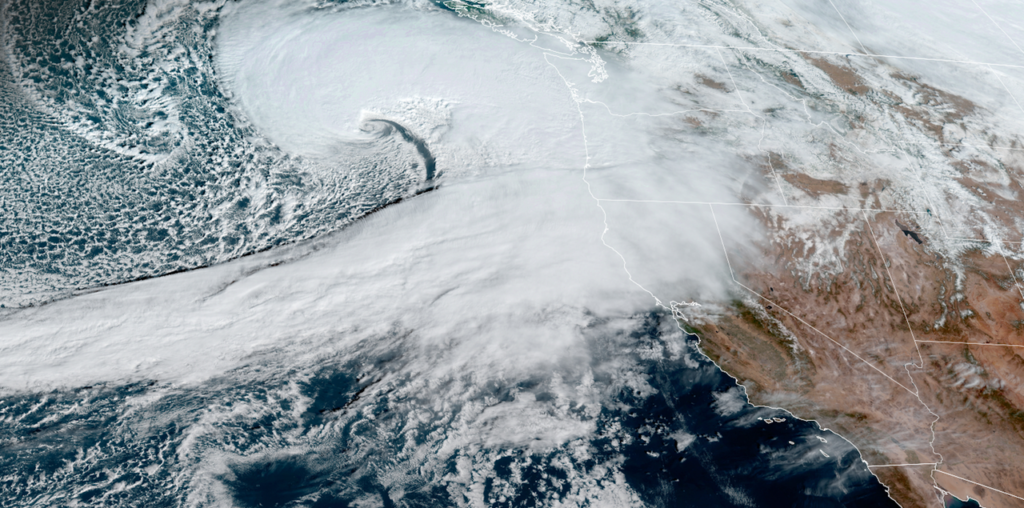
The West Coast is facing a long-lasting heavy rain event from a bomb cyclone that is taking shape in the northeastern Pacific Ocean, which could lead to significant flooding.
Threat level: The rapidly intensifying storm that is forecast to direct a strong atmospheric river at southwestern Oregon and Northern California for days on end brought hurricane-force winds to parts of Ore., Washington and Canada on Tuesday night, causing widespread power outages and killing at least one person.
- The National Weather Service issued a rare “high” likelihood of excessive rainfall from Thursday into Friday, which highlights the danger of more heavy rain on already saturated soils, particularly in northern California. The agency is highlighting precipitation totals of 12 to 16 inches or more, and warns of rock and landslide risks in this region.
- “High risk” days are associated with a majority of all flood-related property losses in the Lower 48 states, and about two out of five flood-related fatalities, according to the NWS’ Weather Prediction Center.
- The forecast office in Eureka, Calif., noted that an atmospheric river producing very heavy rainfall will end up “parking itself” over northwestern California starting Tuesday night and continue potentially into the weekend.
- That’s raising flooding concerns for urban areas as well as rivers and streams over time.
State of play: The latest computer model projections show rainfall amounts that could reach 15 to 20 inches, or even higher, along coastal areas. The highest totals will be in elevated areas as the low-pressure system explosively intensifies offshore.
- National Weather Service data shows the Washington cities of Sunrise (Rainier) and Enumclaw saw wind gusts of 77 mph, 74 mph, respectively Tuesday evening; Oregon’s Gold Beach and other coastal locations in the state saw maximum wind gusts the 70s; the NWS Bay Area reported wind gusts of over 50 mph north of San Francisco and noted a there was a gust of a 101mph gust off the coast of Vancouver, Canada.
- A woman in her 50s died Tuesday evening after a “large tree fell on a homeless encampment” in Lynnwood, Wash., during heavy winds connected to the bomb cyclone, per a South County Fire Facebook post.
- An estimated 555,000-plus people were without power in Washington, where the NWS Seattle said there were “multiple reports of trees down around the Puget Sound area” early Wednesday. Thousands also had no electricity in parts of California and Oregon overnight.
Zoom in: The bomb cyclone is expected to continue to bring winds of up to 100 mph off the coast of Vancouver Island and west of Washington state as itreaches its peak intensity by Wednesday, before drifting off the coast while weakening into the weekend.
- Offshore wave heights could hit 70 feet, and high surf will pound the coastline of the Pacific Northwest.
- The low pressure area will qualify as a bomb cyclone due to its rapid rate of intensification.
- In fact, it may greatly exceed the meteorological definition of the phenomenon known as “bombogenesis,” when a low pressure area intensifies by at least 24 millibars in 24 hours.
- This storm may intensify by as much as 50 millibars or more in that same timespan. As a general rule, stronger storms have lower minimum central air pressures associated with them.
What we’re watching: At its peak intensity, the storm could qualify as one of the strongest low-pressure areas yet recorded in that region.
The big picture: To the south of the bomb cyclone’s center, an atmospheric river will carry copious amounts of moisture from the subtropics into Northern California and parts of Oregon.
- As their name suggests, atmospheric rivers are corridors of concentrated water vapor located in the middle atmosphere, about 10,000 to 20,000 feet above the surface.
- This particular atmospheric river event is forecast to rate as a 4 out of 5 on the Scripps Institution of Oceanography’s severity scale, which takes into account the potential for heavy rainfall.
Context: Human-caused climate change is causing atmospheric rivers to carry more moisture and making them capable of producing more rain and snow.
- One 2022 study found that atmospheric rivers that hit California in 2017 were up to 15% wetter due to human-caused climate change.
- Other recent studies show future atmospheric river events may heighten this trend.
- Warmer air and ocean temperatures add more water vapor to the atmosphere, which storms can ingest and wring out over land.
In California, atmospheric rivers have been responsible for some of the biggest flooding events on record, though this storm’s heavy rain and mountain snow aren’t expected to lead to a historic event.
The bottom line: Climate change is increasing the severity of heavy precipitation events, including atmospheric rivers, such as this one.
Editor’s note: This a breaking news story. Please check back for updates.

